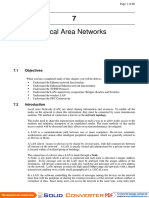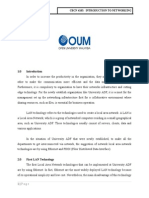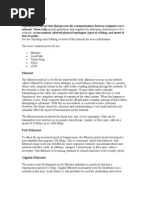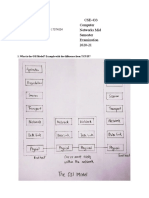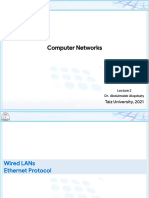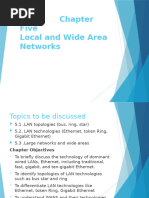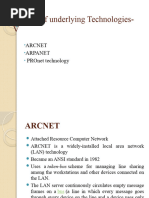Arcnet 2
Arcnet 2
Uploaded by
Boris BarzalloCopyright:
Available Formats
Arcnet 2
Arcnet 2
Uploaded by
Boris BarzalloOriginal Description:
Original Title
Copyright
Available Formats
Share this document
Did you find this document useful?
Is this content inappropriate?
Copyright:
Available Formats
Arcnet 2
Arcnet 2
Uploaded by
Boris BarzalloCopyright:
Available Formats
Using ARCNET for industrial
and embedded networking
applications
Frederick Weber
Don He
Director of Strategic Marketing
Standard Microsystems Corporation (SMsC)
Product Manager
Contemporary Control Systems, Inc.
1. Overview
As we gain momentum in the millennium, the possibilities with
regard to network protocols are endless. This paper examines
the basic specifications of several major network protocols such
as Ethernet and ARCNET and the benefits of implementing a
token-passing protocol for industrial applications. When selecting a network protocol for Embedded or Industrial applications
the key point to consider is the networks ability to manage
real-time events. Specifically, each node needs to guarantee the
maximum waiting time to communicate. Additionally, design
considerations like data integrity, throughput, flexible topology interface and synchronization play a major role in the selection process and their performance characteristics are well
suited for control. With the emergence of a host of protocols in
recent years, the token-passing scheme is the best solution for
industrial applications because its deterministic performance
ensures that controlled events occur when they must.
that it is okay to transmit. Both stations start to transmit
frames of data at slightly different times.
2. Their signals propagate away from the points of origin
toward the ends of the wire.
3. The signals collide. Station C, being the nearest transmitting station to the point of collision, detects the collision first and starts broadcasting jamming signals.
4. Station A receives the jamming signal before it finishes
transmitting its data. Now both stations A and C are aware
that a collision has corrupted their transmissions. Both
will now back off and try their transmissions again.
Data delivery to the address is not guaranteed in this method.
2. Network Protocols
2.1 Ethernet
Xerox s Palo Alto Research Center (PARC) developed Ethernet
(the 2.94 Mbps version) in the early 70s. Ethernet is a descendent of early network technologies, including the ALOHA network. The design objective was to create a simple yet efficient
and inexpensive LAN architecture. Ethernet made its commercial debut in 1980 as the collective product of Xerox, Digital
Equipment Corp., and Intel, which boosted the speed of Ethernet
to 10 Mbps. An improved Ethernet II was released in 1982. By
1985, the Institute of Electrical and Electronic Engineers (IEEE)
developed open network standards through the 802 Working
Committee and formed its 802.3 Committee. The 802.3 Committee published the IEEE 802.3 Carrier Sense Multiple Access with Collision Detection (CSMA/CD) Access Method and
Physical Layer Specifications.
Ethernet is based on CSMA/CD, which means multiple
nodes can transmit over a single wire.
The graphic below illustrates Ethernets collision detection
and recovery mechanism:
1. Both stations A and C sense the network wire for an ongoing transmission. Sensing none, both stations decide
The formats for an Ethernet and an 802.3 frame are shown
in the chart below. The two used in industry are similar. Both
can be used on the same network. Ethernet devices can distinguish the two types of Ethernet frames. The function of each
field within the frames is described below.
2.2 CAN
CAN employs CSMA/CA (Carrier Sense Multiple Access/
Collision Avoidance). Medium access control is accomplished
using a technique called non-destructive bit-wise arbitration.
Individual nodes brand messages with a unique identifier,
sending their data onto the network. This allows the node to
track the data to ensure successful transmission. If successful
International IC China Conference Proceedings 453
transmission does not occur, the station assumes that a higher
priority message is being sent. Therefore, it halts transmission
and reverts to receive mode. The highest priority message gets
through and the lower priority messages are re-sent at another
time.
This approach has one primary advantage. Collisions on the
network do not destroy data and eventually all stations gain
access to the network. Unfortunately, this approach creates a
problem. The arbitration is done on a bit-by-bit basis requiring
all stations to hear one another within a bit-time (actually less
than a bit-time). At a 500 Kbps bit-rate, a bit-time is 2000ns
which does not allow sufficient time for transceiver and cable
delays. The result is that CAN networks are usually quite short,
frequently less than 100 meters in length at higher speeds. To
increase this distance either the data rate is decreased or additional equipment is required.
The formats for a CAN standard frame are shown in the
chart below.
2.3 ARCNET
The Datapoint Corporation introduced ARCNET the (Attached
Resource Computer Network) in the late 70s which employs a
Token-Passing protocol. The ARCNET protocol has been a
premier choice for embedded designers since the mid-80s. Originally designed for office automation, ARCNET has found its
niche in industrial and embedded real-time applications.
ARCNET is the ideal solution for applications where a deterministic protocol is preferred or required. This deterministic
protocol, based on a token-passing scheme, guarantees delivery of data within a predetermined time frame. ARCNET continues to be a quiet success story in Industrial and Embedded
markets given its high fault tolerance, flexibility to interface
easily with various media, host processors and industrial temperature range. It is suitable fieldbus technology.
A token (ITT) is a unique signaling sequence passed in
an orderly fashion among all the active nodes in the network.
When a particular node receives the token, it has the sole right to initiate a transmission sequence
or it must pass the token to the
next logical node. This neighbor, which can be physically
located any where on the network, has the next highest address to
the node with the token regardless of the networks physical
topology. Once the token is passed, the recipient also has the
right to initiate a transmission. This token-passing sequence continues in a logical ring fashion serving all nodes equally. Node
addresses range from 0 to 255 with 0 reserved for broadcast
messages.
In a transmission sequence, the node with the token becomes
the source node. Any other node selected by the source node
for communication becomes the destination node. First the
source node inquires if the destination node is in a position to
accept a transmission by sending a Free Buffer Enquiry (FBE).
The destination node responds by returning a Acknowledgement
(ACK) meaning that a buffer is available or by returning a Negative Acknowledgment (NAK) meaning that no buffer is available. Upon an ACK, the source node sends out a data transmission from 1 to 507 bytes of data (PAC). If the data was properly
454 International IC China Conference Proceedings
received by the destination node as evidenced by a successful
CRC test, the destination node sends another ACK. If the transmission was unsuccessful, the destination node does nothing,
causing the source node to timeout. Therefore, the source node
will infer that the transmission failed and will retry after it receives the token on the next token pass. The transmission sequence terminates and the token is passed to the next node. If
the desired message exceeds 507 bytes, the message is sent as a
series of packets one packet every token pass. This is called
a fragmented message. The packets are recombined at the destination end to form the entire message.
Another feature of ARCNET is its ability to reconfigure the
network automatically if a node is either added or deleted from
the network. If a node joins the network, it does not automatically participate in the token-passing sequence. Once a node
notices that it is never granted the token; it will jam the network with a reconfiguration burst that destroys the token-passing sequence. Once the token is lost, each node will cease transmitting and begin a timeout sequence based upon their own
node address. The node with the highest address will timeout
first and begin a token pass sequence to the node with the next
highest address. If that node does not respond, it is assumed not
to exist. The destination node address is incremented and the
token resent. This sequence is repeated until each a node responds. At that time, the token is released to the responding
node and the address of the responding node is noted as the
logical neighbor of the originating node. This sequence is repeated by all nodes until each node learns its logical neighbor.
At that time the token passes from neighbor to neighbor without wasting time on absent addresses.
The formats for ARCNET frames are shown in the chart
below. ARCNET allows both short and long frames.
3. CSMA/CD(Ethernet) versus Token-Passing
CSMA/CD
The Ethernet protocol, simply states the following if you want
to transmit a message. Listen for the carrier from other transmitters. If no carrier is detected, then send and listen. If you
hear something different from what you sent, you are detecting
a collision. Stop transmission and wait a stochastic time delay
and start the procedure again. The collision is a function of the
carrier (signal) propagation delay from node-to-node. The probability of a collision is dependent on propagation delay and the
frequency of message transmission. The carrier offers a certain
data band width. This band width can be used to send long
messages such as files or short but frequent messages such as
sample data in Industrial Process Control Systems. The probability for collision will become greater by increasing the frequency of the messages.
Token-Passing
Only one token exists with this protocol. Therefore, no collision can result. Reconfigurations occur by nodes not being serviced or nodes no longer finding successive nodes as destinations for the token.
The overhead associated with the token-passing is best
explained as the token circulating from node-to-node even when
the network is idle, creating the situation that the token simply
passes when no message transmission occurs. The only drawback to the token-passing system as compared to the CSMA/
CD is the minimal time delay when the node has to wait for the
token.
When heavily loaded, the performance of a token-passing
network generally exceeds that of a CSMA/CD network and
more important, the performance is deterministic. Both network
types are of the Flying Master type, i.e. all nodes are identical in functionality, they can receive and initiate transmission
themselves.
Proponents of token-passing argue that because there are
no collisions with token-based protocol, their networks have
the best behavior under heavy loads because the time performance of the networks are deterministic, making it easier to
know whats happening. Advocates of contention view that most
networks operate under lighter load conditions where low overhead translates into greater throughput and efficiency. They also
state the greater cost of token-passing networks.
Reconfiguration - a new node joins the ring automatically
without software intervention
Broadcast and Directed Messages
Multi-master with automatic token generation
Cabling Options - Coax, Fiber, RS485 twisted pair
High Speed - Standard 2.5Mbps, optionally 156Kbps to
10Mbps
Low-cost chips
Low Protocol Overhead - 3 or 4 bytes
Packet Size - small (253 bytes or less) or large (508) bytes
Benefits
Used for industrial high-speed applications
Used in embedded design to communicate between
controllers
A multi-master network of nodes allows equal access to
all nodes
Simple Low Cost Hardware Design - one chip + transceiver
Software drivers are packet driven
Noise Immunity
4. ARCNET for Real-time Applications
6. ARCNET Example
ARCNET, Token-Passing protocol local area network (LAN),
is ideally suited for real-time control applications. In terms of
the International Organization of Standards - OSI (Open Systems Interconnect) Reference Model, ARCNET provides the
Physical and Data-link layers. In other words, ARCNET successfully transmits and receives a data packet between two network nodes. A node refers to an ARCNET controller chip and
cable transceiver connected to the network. Nodes are assigned
addresses called MAC (medium access control) Ids and one
ARCNET network can have up to 255 uniquely assigned nodes.
The key to ARCNETs performance is its token-passing protocol. In a token-passing network, a node can only send a message when it receives the token. This is the preferred media
access control method because all nodes have equal access to
the network, eliminating transmission collisions on busy networks. In fact, the worst case time for receiving a token can be
calculated, an important feature for real-time systems. In other
words, ARCNET provides deterministic performance. Finally,
the ARCNET protocol knows when nodes are added to or
deleted from the network and automatically reconfigures the
network accordingly without software intervention.
A typical example is given below of a photo development and
printing (DPE) system. All function modules for the system are
now connected with ARCNET, which makes the internal connection between the modules much simpler than the original
system.
Bibliography
This documents content is a composition of information from
Standard Microsystems Corporation and ARCNET Trade
Association.
Authors contact details
5. ARCNET Features & Benefits
ARCNET provides the physical and data link layers and some
of the transport functions (flow control and hardware packet
acknowledgement) of the OSI network model. The ARCNET
equipment provides reliable packet delivery and network administration with little software effort.
Features
Deterministic Performance - users can calculate the worst
case node-to-node message time
Logical Ring - nodes automatically find their neighbor to
create a ring; Automatic
Frederick Weber
SMSC
80 Arkay Drive
P.O. Box 18047
Hauppauge, NY 11788 USA
Phone: (1-631) 435 6171
Fax: (1-631) 435 6110
E-mail: fred.weber@smsc.com
Don He
Contemporary Control Systems, Inc.
2431 Curtiss Street
Downer Grove, IL 60515 USA
Phone: (1-630) 963 7070
Fax: (1-630) 963 0109
E-mail: dhe@ccontrols.com
International IC China Conference Proceedings 455
Presentation Materials
456 International IC China Conference Proceedings
International IC China Conference Proceedings 457
458 International IC China Conference Proceedings
International IC China Conference Proceedings 459
460 International IC China Conference Proceedings
International IC China Conference Proceedings 461
462 International IC China Conference Proceedings
International IC China Conference Proceedings 463
You might also like
- A Summer Training Report NetworkingDocument44 pagesA Summer Training Report NetworkingMuditSinghChoudharyNo ratings yet
- Slides of Discovering Statistics Using SPSS by Muhammad Yousaf Abid. Iqra University Islamabad.Document31 pagesSlides of Discovering Statistics Using SPSS by Muhammad Yousaf Abid. Iqra University Islamabad.M Yusuf SlatchNo ratings yet
- Mid Term Subjective Cs610Document5 pagesMid Term Subjective Cs610Rashid MehmoodNo ratings yet
- ch6 Network PDFDocument28 pagesch6 Network PDFomerNo ratings yet
- Other Technologies & Network Architecture: Session 7Document23 pagesOther Technologies & Network Architecture: Session 7Aravind BhomboreNo ratings yet
- Networks 12222 1Document15 pagesNetworks 12222 1عمر محمد احمد جوده 949No ratings yet
- SYN CH - 1 and 2Document20 pagesSYN CH - 1 and 2IG TECHNo ratings yet
- Local Area NetworkDocument17 pagesLocal Area NetworktanyabachanNo ratings yet
- A Set of Network Standards Developed by The IEEE. They IncludeDocument19 pagesA Set of Network Standards Developed by The IEEE. They IncludeYogendra RajavatNo ratings yet
- Logical TopologyDocument7 pagesLogical Topologyitssathish16No ratings yet
- LAN and Ethernet Basics - Deepak George: OSI Network LayersDocument12 pagesLAN and Ethernet Basics - Deepak George: OSI Network LayersUseful Videos DevotionalNo ratings yet
- Master of Computer Application (MCA) - Semester 3 MC0075 - Computer Networks - 4 CreditsDocument33 pagesMaster of Computer Application (MCA) - Semester 3 MC0075 - Computer Networks - 4 CreditsVrinda RajputNo ratings yet
- ch5,6Document54 pagesch5,6animut0934No ratings yet
- Introducing To NetworkingDocument5 pagesIntroducing To Networkinggheorghe_tiberiu96No ratings yet
- Dell EMC NetworkingDocument72 pagesDell EMC Networkingsts100No ratings yet
- 2 Link Layer Technologies: T.O.P. Businessinteractive GMBH Page 1 of 18Document18 pages2 Link Layer Technologies: T.O.P. Businessinteractive GMBH Page 1 of 18Daniel CafuNo ratings yet
- CCNET Handbook - Good Summary For Networking IdeasDocument42 pagesCCNET Handbook - Good Summary For Networking IdeasAnas ElgaudNo ratings yet
- Data Communication and NetworkingDocument21 pagesData Communication and NetworkingH-Muhaimen Ul AzizNo ratings yet
- A Paper On EthernetDocument4 pagesA Paper On Ethernetaayushahuja1991No ratings yet
- Bscsupportgi Tokenrng CISCO Token - ArticleDocument6 pagesBscsupportgi Tokenrng CISCO Token - Articlekaushik4endNo ratings yet
- S7 Ethernet-Local Area Network: GROUP: 4960 Members: William Obaco Alexander Méndez Raúl SaltosDocument47 pagesS7 Ethernet-Local Area Network: GROUP: 4960 Members: William Obaco Alexander Méndez Raúl SaltosByron Xavier Lima CedilloNo ratings yet
- Viva VoceDocument5 pagesViva VocesathishNo ratings yet
- Local Area Networks: 7.1 ObjectivesDocument66 pagesLocal Area Networks: 7.1 ObjectivesAhmedNo ratings yet
- EE-379 Embedded Systems and Applications: Introduction To EthernetDocument25 pagesEE-379 Embedded Systems and Applications: Introduction To EthernetJohn HowardNo ratings yet
- What Is Communication ProtocolsDocument4 pagesWhat Is Communication ProtocolsLaheeba ZakaNo ratings yet
- Unit 2 CNDocument35 pagesUnit 2 CNmsk.official321No ratings yet
- Tshoot EthernetDocument11 pagesTshoot Ethernetmrigank shekhar100% (1)
- What Is NGN-WPS OfficeDocument17 pagesWhat Is NGN-WPS OfficeYawar ArslanNo ratings yet
- Buoi 3.1 EthernetDocument35 pagesBuoi 3.1 EthernetThái TrầnNo ratings yet
- NetworkDocument67 pagesNetworkBiplov SapkotaNo ratings yet
- To Identify Where The Frame Starts and Ends To Distinguish Data Bits From Control BitsDocument6 pagesTo Identify Where The Frame Starts and Ends To Distinguish Data Bits From Control BitsLeonardo Alberto Conde TorresNo ratings yet
- CN - 2-Mark-Q-Bank - (Unit-I, Ii)Document12 pagesCN - 2-Mark-Q-Bank - (Unit-I, Ii)keshav sainiNo ratings yet
- Networks, Part 1: What Is A Network?Document4 pagesNetworks, Part 1: What Is A Network?Mohammad Hammad RashidNo ratings yet
- The Basics of Ethernet The Basics of Ethernet The Basics of Ethernet The Basics of EthernetDocument6 pagesThe Basics of Ethernet The Basics of Ethernet The Basics of Ethernet The Basics of EthernetRupesh Kumar100% (1)
- CBCN 4103 Introduction To Networking - EssayDocument10 pagesCBCN 4103 Introduction To Networking - EssayAttenuator JamesNo ratings yet
- Addis Ababa University Addis Ababa Institute of Technology School of Electrical and Computer EngineeringDocument10 pagesAddis Ababa University Addis Ababa Institute of Technology School of Electrical and Computer Engineeringhenok abebeNo ratings yet
- Network Devices & CablesDocument8 pagesNetwork Devices & Cablesapi-26530736100% (1)
- Unit IIIDocument11 pagesUnit IIIJayprakash DuveNo ratings yet
- CSP Unit 3Document28 pagesCSP Unit 3m.revathiNo ratings yet
- Mahlatse Iven Somela Unique Number: 640309 Student Number: 60232811 ICT1532: Assignment 1 Section ADocument9 pagesMahlatse Iven Somela Unique Number: 640309 Student Number: 60232811 ICT1532: Assignment 1 Section Amahlatse iven somelaNo ratings yet
- Chapter-1: 1.1 What Is A Virtual Private Network?Document81 pagesChapter-1: 1.1 What Is A Virtual Private Network?Geetha NamavaramNo ratings yet
- Ethernet Is The Name Given To A Popular Packet-Switched LAN Technology InventedDocument6 pagesEthernet Is The Name Given To A Popular Packet-Switched LAN Technology InventedjyothisNo ratings yet
- Networking (2023)Document6 pagesNetworking (2023)chandarohit201No ratings yet
- Tokken Ring DataDocument19 pagesTokken Ring Dataali HassanNo ratings yet
- Chapter 0Document48 pagesChapter 0Moha KachawNo ratings yet
- ProtocolDocument3 pagesProtocolsharepoint88No ratings yet
- Dept of CSE, Acharya Institutes of TechnologyDocument18 pagesDept of CSE, Acharya Institutes of TechnologyShaishav Shailesh PandyaNo ratings yet
- CCNA Study GuideDocument5 pagesCCNA Study Guideasmith2112No ratings yet
- Computer Networks Midsems 17074004Document8 pagesComputer Networks Midsems 17074004Kumar shivamNo ratings yet
- Ethernet: 1.0 AbstractDocument11 pagesEthernet: 1.0 AbstractNor FazlinaNo ratings yet
- Introduction To LAN Protocols: Chapter GoalsDocument8 pagesIntroduction To LAN Protocols: Chapter GoalsNaveen BorahNo ratings yet
- Opnet ResearchDocument7 pagesOpnet Researchhossam80No ratings yet
- Computer Networks Computer Networks: Taiz University, 2021 Taiz University, 2021Document54 pagesComputer Networks Computer Networks: Taiz University, 2021 Taiz University, 2021alshamiripooi100No ratings yet
- Lan WanDocument48 pagesLan WanBadasa GalchuNo ratings yet
- Computer Networks FAQsDocument134 pagesComputer Networks FAQsAmit SangaleNo ratings yet
- Networking Interview Questions and Answers PDFDocument13 pagesNetworking Interview Questions and Answers PDFwazad asmaNo ratings yet
- Review of Underlying Technologies - V - 1 - 1Document17 pagesReview of Underlying Technologies - V - 1 - 1jackk3585No ratings yet
- Token Bus (IEEE 802.4)Document10 pagesToken Bus (IEEE 802.4)Sayandip MondalNo ratings yet
- Cisco Certified Network Associate (CCNA) and Cisco Certified Network Professional (CCNP): Mastering Network Automation and Programmability Study GuideFrom EverandCisco Certified Network Associate (CCNA) and Cisco Certified Network Professional (CCNP): Mastering Network Automation and Programmability Study GuideNo ratings yet
- CompTIA Network+ (N10-009) Study Guide: Comprehensive Exam Preparation and Key Concepts for Network ProfessionalsFrom EverandCompTIA Network+ (N10-009) Study Guide: Comprehensive Exam Preparation and Key Concepts for Network ProfessionalsNo ratings yet
- Final Exam Booklet - Grade 9 - Term 1Document15 pagesFinal Exam Booklet - Grade 9 - Term 1rz79g8kddrNo ratings yet
- Role of Home Libraries in Rural Districts of Malaysia in Creating A Knowledge SocietyDocument12 pagesRole of Home Libraries in Rural Districts of Malaysia in Creating A Knowledge SocietySaidatul Akmar IsmailNo ratings yet
- CSI Sample Cover LettersDocument8 pagesCSI Sample Cover Letterspscnr2013No ratings yet
- A Proper GoodbyeDocument2 pagesA Proper GoodbyerichellehyattNo ratings yet
- The SAP BPC Path To S4 HANA Finance What Does It Mean For You Justin McNeely PDFDocument11 pagesThe SAP BPC Path To S4 HANA Finance What Does It Mean For You Justin McNeely PDFNisit PayungkorapinNo ratings yet
- Employee EngagementDocument37 pagesEmployee EngagementAnjali LakraNo ratings yet
- Forage Collection and Identification HerbariumDocument2 pagesForage Collection and Identification Herbariumcristine abridaNo ratings yet
- Research Pablo Lacara MusniDocument19 pagesResearch Pablo Lacara MusniKASHIECA CLAIRE PANINGBATANNo ratings yet
- Modul Pengolahan Citra DigitalDocument25 pagesModul Pengolahan Citra Digitalfeelmaarrow arrowNo ratings yet
- New Relationship and New Story of Your SPDocument3 pagesNew Relationship and New Story of Your SPjordenjulianNo ratings yet
- Linear Algebra PresentationDocument22 pagesLinear Algebra PresentationArsalan AhmedNo ratings yet
- EnglishDocument15 pagesEnglishCENA SECTIONNo ratings yet
- Thesis About My DadDocument8 pagesThesis About My Dadbsqxd5g1100% (1)
- 2.1.5 The Knobless CylindersDocument3 pages2.1.5 The Knobless CylindersAdhirajNo ratings yet
- Butterfly PDFDocument24 pagesButterfly PDFzakir hussainNo ratings yet
- ISO - 24213 - Avaliação de SpringbackDocument18 pagesISO - 24213 - Avaliação de Springback0511018No ratings yet
- Parent'S Permit: Tacloban City Title of Form: Parent's Permit Control No. EVSU-SASO-F-026 Revision No. 0 DateDocument1 pageParent'S Permit: Tacloban City Title of Form: Parent's Permit Control No. EVSU-SASO-F-026 Revision No. 0 DateMee Lai Calinao100% (1)
- Supplier QuestionnaireDocument12 pagesSupplier QuestionnairejcalderonscNo ratings yet
- Year 9 Maths Specimen Paper 3Document11 pagesYear 9 Maths Specimen Paper 3kareemyas7120No ratings yet
- Write The Correct Answer On The Blank. Solve Each Item On A Scratch Paper, When NecessaryDocument4 pagesWrite The Correct Answer On The Blank. Solve Each Item On A Scratch Paper, When NecessaryWinnie PoliNo ratings yet
- Six Sigma Presentation FinalDocument38 pagesSix Sigma Presentation Finalnayanvm100% (1)
- Microinteractions in User ExperienceDocument21 pagesMicrointeractions in User ExperienceEdina JakabNo ratings yet
- Claim Slip Claim Slip: - SCHOOL - SCHOOLDocument2 pagesClaim Slip Claim Slip: - SCHOOL - SCHOOLFerdinand OrigenesNo ratings yet
- Android Phone Controlled Spy RobotDocument4 pagesAndroid Phone Controlled Spy RobotInternational Journal of Innovative Science and Research Technology100% (2)
- CV Template FaisalDocument2 pagesCV Template Faisalapi-358748550No ratings yet
- PS3 GamesDocument6 pagesPS3 GamesDiego MontanoNo ratings yet
- CSC118 - Fundamentals of Algorithm DevelopmentDocument3 pagesCSC118 - Fundamentals of Algorithm Developmentmohdkhairi0% (1)
- Rundown Icle 4Document8 pagesRundown Icle 4RONY ARAHTA SEMBIRINGNo ratings yet
- Prepared By: Raja Nazian AdilaDocument39 pagesPrepared By: Raja Nazian Adilathehrmaven2013No ratings yet






















